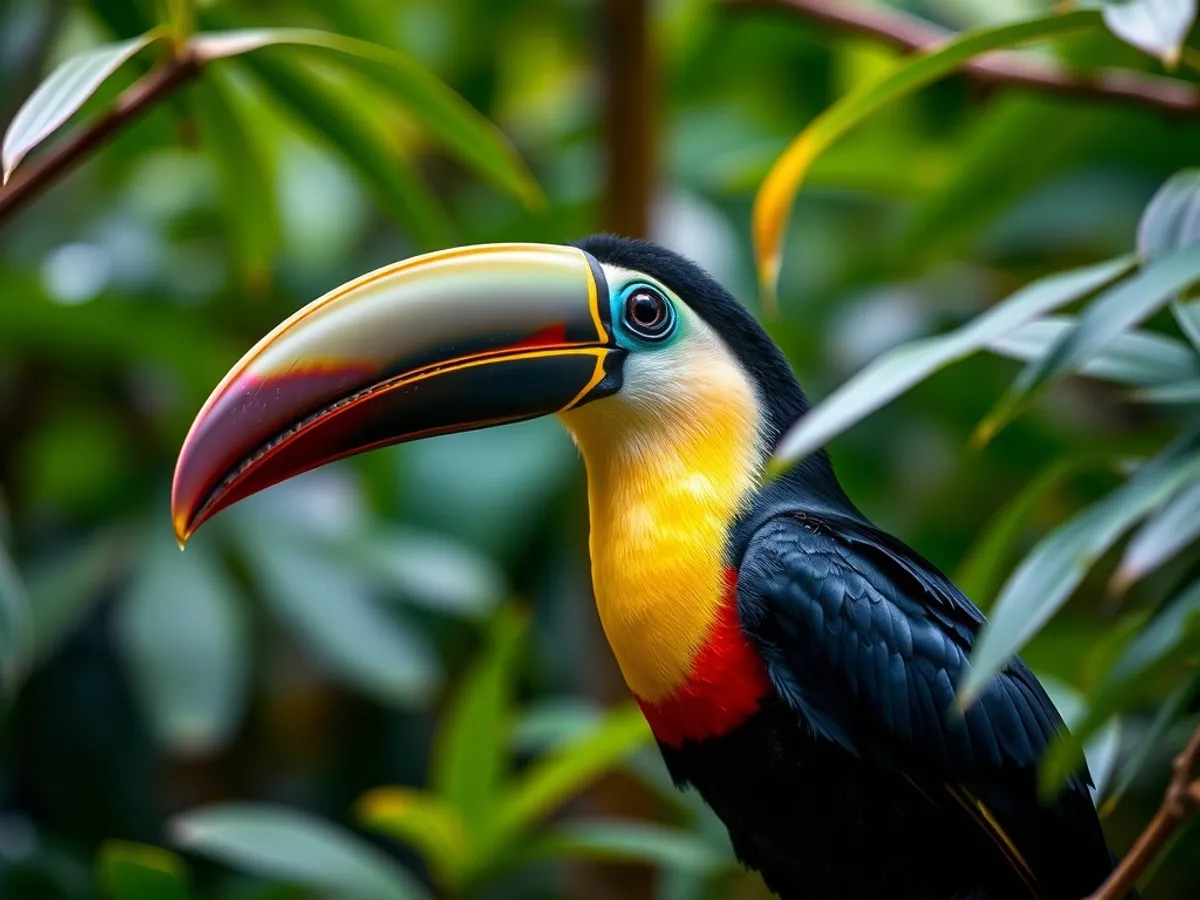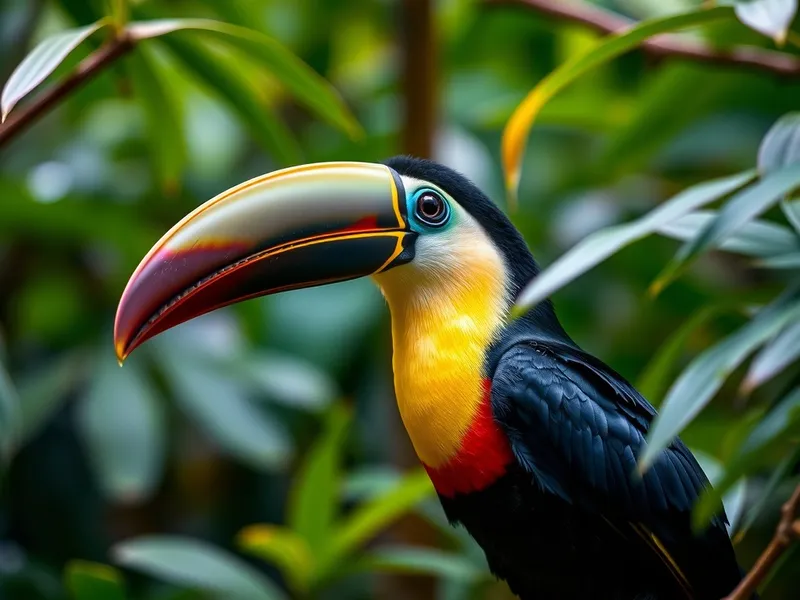
Keel-billed Toucan
Ramphastos sulfuratus

Meet the Keel-billed Toucan
The Keel-billed Toucan is a vividly colored bird renowned for its large, multi-hued bill that can measure up to one-third of its body length. Native to the tropical rainforests of Central and South America, this toucan is highly social and often seen in small flocks. Its plumage is primarily black with a bright yellow throat and chest, while its bill displays a spectacular blend of green, orange, red, and blue. Despite its hefty appearance, the bill is lightweight and aids in feeding and thermoregulation.
Classification
Bird
Habitat
Tropical rainforest
Diet
Omnivore
Lifespan
15-20 years
Conservation
Least Concern
Weight
380-500 g
📖Fascinating Facts
Colorful Bill
The Keel-billed Toucan's bill can be up to 15 cm long and is a striking combination of green, red, orange, and blue hues.
Fruit Lover
Although primarily frugivorous, Keel-billed Toucans also eat insects, eggs, and small reptiles, making them opportunistic omnivores.
Social Bird
They are highly social and often roost together in tree cavities, sometimes with several birds crammed into a single hole.
📋Detailed Description
The Keel-billed Toucan (Ramphastos sulfuratus) is a medium-sized toucan, measuring 42–55 cm (16.5–21.5 in) in length and weighing 380–500 g (13–18 oz). Its most distinctive feature is its enormous, laterally compressed bill, which can reach up to 12–15 cm (4.7–5.9 in) long and is vividly colored with green, orange, red, and blue hues. Despite its size, the bill is composed of a spongy, lightweight keratin structure supported by internal bony struts, making it surprisingly light and functional. The plumage is predominantly black, contrasting with a bright yellow throat and upper breast, a white band at the base of the tail, and red undertail coverts. The feet are zygodactylous (two toes forward, two backward), aiding in grasping branches. The eyes are surrounded by bare, greenish skin. Keel-billed Toucans are highly social, often found in small groups of 2–12 individuals, and are known for their playful, acrobatic movements among the canopy. Their vocalizations are distinctive, consisting of croaking or frog-like calls. They are primarily arboreal and rarely descend to the ground, spending most of their lives in the mid to upper canopy of humid lowland forests, forest edges, and secondary growth.
💡 Did you know?
Despite their large and colorful bills, Keel-billed Toucans are surprisingly quiet, producing frog-like croaks rather than loud calls.
🔬Research & Sources
Wikipedia Summary
The keel-billed toucan, also known as sulfur-breasted toucan, keel toucan, or rainbow-billed toucan, is a colorful Latin American member of the toucan family. It is the national bird of Belize. The species is found in tropical jungles from southern Mexico to Ecuador. It is an omnivorous forest bird that feeds on fruits, seeds, insects, invertebrates, lizards, snakes, and small birds and their eggs.
Last Modified: 5/26/2025
🎭Behavior & Social Structure
Keel-billed Toucans exhibit complex social behaviors, frequently engaging in mutual preening and bill-fencing play, which may reinforce social bonds. They are diurnal, foraging in the early morning and late afternoon, and roost communally at night in tree cavities, sometimes with several birds sharing the same space. Their feeding behavior is opportunistic and versatile: they use their long bills to reach and pluck fruit from branches that might otherwise be inaccessible, and to deftly toss food items into the air before swallowing them whole. While primarily frugivorous, they supplement their diet with insects, small reptiles, eggs, and nestlings, especially during the breeding season when protein needs increase. Toucans are important seed dispersers, as they often regurgitate or defecate seeds far from the parent tree, aiding forest regeneration. They are agile climbers but weak fliers, moving between trees with short, undulating flights.
👶Reproduction & Life Cycle
Breeding typically occurs from March to June, though timing can vary regionally. Keel-billed Toucans are monogamous during the breeding season, with pairs often engaging in mutual preening and bill-touching displays. Nests are made in natural or previously excavated tree cavities, usually 2–30 meters above ground. The female lays 2–4 white eggs, which are incubated by both parents for about 15–20 days. After hatching, both parents participate in feeding and caring for the altricial chicks. The nestlings are born blind and naked, with specialized heel pads to protect them from the rough cavity floor. Fledging occurs after 6–9 weeks, at which point the young begin to accompany adults in small family groups.
🛡️Adaptations & Survival
The toucan’s oversized bill is a multifunctional adaptation: it enables access to a wide variety of fruits, serves as a tool for manipulating objects, and plays a role in social interactions and mate selection. Recent research has shown the bill is also an effective thermoregulatory organ, allowing the bird to dissipate excess body heat by adjusting blood flow to the bill’s surface. Their zygodactylous feet and strong legs provide excellent grip and maneuverability among branches. Cryptic nesting in tree cavities protects eggs and chicks from many predators. Their bright coloration may serve as a warning to potential predators or as a means of species recognition within dense forest habitats.
📚Research Sources
🎨Cultural Significance
The Keel-billed Toucan is the national bird of Belize and features prominently in local folklore, art, and tourism branding. Its striking appearance has made it a symbol of tropical biodiversity and a popular subject in indigenous mythology, often associated with rainbows, communication, or as a messenger between worlds. In some Mesoamerican cultures, toucans were believed to possess spiritual powers or serve as intermediaries with the gods. Today, the bird is widely used in ecotourism promotion and environmental education across Central America.
🔬Recent Research & Discoveries
Recent studies have focused on the toucan’s bill as a model for bioinspired engineering, particularly its lightweight yet strong structure. Research published in Science (Tattersall et al., 2009) demonstrated the bill’s role in thermoregulation, revealing that toucans can control heat loss by adjusting blood flow. Ongoing ecological research investigates their role as keystone seed dispersers and their responses to habitat fragmentation. Genetic studies are clarifying population structure and subspecies boundaries, with some evidence of hybridization in contact zones. Conservation research is monitoring population trends and the effectiveness of protected areas.
🎥Wildlife Videos

Jewel of the Jungle: The Keel Billed Toucan in 4K Close-ups. #birds #4kvideo #documentary
Welcome to 'Jewel of the Jungle: The Keel Billed Toucan in 4K Documentary'. Dive into the dense green rainforests with us as we ...
Pristine Planet 4K

Keel-Billed Toucan: The Rainbow-Billed Beauty of the Rainfores | Nature Documentary
Keel-Billed Toucan: The Rainbow-Billed Beauty of the Rainfores | Nature Documentary Join us on an unforgettable journey into ...
Forest Edition

The Keel Billed Toucan in 4K Close-ups. #birds #4kvideo #documentary#ExploreNature#bird
Animal Connection makes informative, fascinating, interesting and funny videos about our favorite animals. Here you can find the ...
Explore the World

Keel Billed Toucan is the most flamboyant bird in the Americas
Follow us on instagram.com/the4kguy Send a video: bit.ly/37cqWV1 With a beak larger than life, the Toucan has to be one of the ...
The 4K Guy - Nature & Urban

Toucan | One Of The Most Unique Birds On Earth
Toucan is one of the most beautiful and unique birds in the world. They have large and colorful beaks. #shorts #toucan #toucans ...
Nature Lens

Toucans | Colorful Birds | Iconic Bills
Welcome to the world of toucans! In this exciting video, we bring you 20 incredible facts about these captivating and colorful birds ...
Lord of Animals
🌍Habitat Information
The Keel-billed Toucan typically inhabits Tropical rainforest environments. Keel-billed Toucans have adapted to their environments with specialized features and behaviors.
Primary Habitat:
Tropical rainforest
More detailed habitat information will be available soon.
🛡️Conservation Status
The Keel-billed Toucan is currently classified as Least Concern. Conservation efforts are crucial for preserving this species for future generations.
Common Threats:
- 🏠Habitat loss and fragmentation
- 🌡️Climate change impacts
- 🎯Hunting and poaching
- 🏭Human-wildlife conflict
⚠️Threats & Conservation Challenges
The Keel-billed Toucan faces threats from habitat loss due to deforestation, agricultural expansion, and urbanization throughout its range. Illegal pet trade and hunting for feathers or as trophies also pose localized risks. Although still relatively widespread, populations are declining in some areas, leading to its current IUCN status as Near Threatened. Fragmentation of forest habitats can isolate populations and reduce genetic diversity. Climate change may further impact food availability and nesting sites. Conservation efforts focus on habitat protection, legal enforcement, and public education.
🔬Scientific Classification
Scientific Name
Ramphastos sulfuratus
Classification Hierarchy
🔍 About Taxonomic Classification
Taxonomic classification is a hierarchical system used by scientists to classify and organize living organisms based on shared characteristics and evolutionary relationships.
The system moves from broad categories (Kingdom) to increasingly specific ones, with each animal's scientific name typically consisting of its Genus and species.
📝Community Notes
Share your observations and insights about the Keel-billed Toucan with our community of wildlife enthusiasts.
Join Our Community
Sign in to share your observations and connect with fellow wildlife enthusiasts.
Sign In to ContributeNo community notes yet
Be the first to share your observations about the Keel-billed Toucan!
Explore Keel-billed Toucan
Select a tab above to learn more about this amazing animal.
📸Photo Gallery
No photos available for this animal yet.
🌟Discover More Wildlife
Continue your journey of discovery with more fascinating animals from our database
